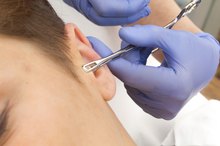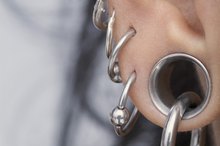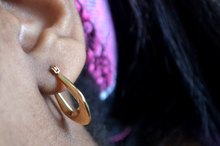What does fact checked mean?
At Healthfully, we strive to deliver objective content that is accurate and up-to-date. Our team periodically reviews articles in order to ensure content quality. The sources cited below consist of evidence from peer-reviewed journals, prominent medical organizations, academic associations, and government data.
The information contained on this site is for informational purposes only, and should not be used as a substitute for the advice of a professional health care provider. Please check with the appropriate physician regarding health questions and concerns. Although we strive to deliver accurate and up-to-date information, no guarantee to that effect is made.
How to Prevent Infection in Pierced Ears
One of the most common places to receive a body piercing is the earlobe. As part of preventing infection, you should only have your ears pierced with a piercing gun that has been cleaned and sterilized. Choose a clean and reputable shop, or check with your physician to see if he performs piercings. Once the ear piercing has been done, follow all after-care instructions to prevent infection.
Clean the ears twice a day. Use warm water and an antibacterial soap. Rinse away all soapy residue and gently pat dry with a towel. Your hands should be washed before handling the pierced portion of the ear.
Places to Get Ears Pierced
Learn More
Rotate the earring two to three times per day. Moving the earring around can help prevent an infection, according to the American Academy of Family Physicians 1. You can perform this task while cleaning the area.
Apply a medicated cleanser as directed by the ear piercing facility. According to the University of Pittsburgh, benzalkonium chloride is typically the active ingredient in these antiseptic cleansers 2. Apply the solution to a cotton ball and rub it onto the piercing site to clean and kill bacteria.
What Are the Dangers of Pierced Ears?
Learn More
Remove visible crusting around the piercing site. Use a cotton ball dampened with distilled water or anticeptic to get rid of any crusting that you notice around the piercing.
Leave the earrings in place. The earrings used during the piercing should not be removed for at least a month.
Warnings
Avoid exposure to any substances that may cause an infection to develop after you have pierced your ears. The University of Pittsburgh recommends cleaning your pillowcase and telephone before placing them against your ear. You should also not expose the area to hair gels, sprays and perfumes.
If you notice pain, swelling or redness around the pierced area, an infection may have developed. Contact your doctor for medical treatment.
Related Articles
References
- American Academy of Family Physicians: Body Piercing
- University of Pittsburgh: Piercing Care and Precautions
- Gabriel OT, Anthony OO, Paul EA, Ayodele SO. Trends and complications of ear piercing among selected Nigerian population. J Family Med Prim Care. 2017;6(3):517–521. doi:10.4103/2249-4863.222045
- Uter W, Werfel T, White IR, Johansen JD. Contact allergy: A review of current problems from a clinical perspective. Int J Environ Res Public Health. 2018;15(6):1108. doi:10.3390/ijerph15061108
- Park JK, Kim KS, Kim SH, Choi J, Yang JY. Reconstruction of a traumatic cleft earlobe using a combination of the inverted V-shaped excision technique and vertical mattress suture method. Arch Craniofac Surg. 2017;18(4):277-281. doi:10.7181/acfs.2017.18.4.277
Writer Bio
Heather Topham Wood is a seasoned writer whose work has appeared in numerous publications, including USA Today, Gadgetell, Feel Rich and Step in Style. Heather is a published novelist with six Amazon bestsellers and a contract through Crescent Moon Press. She holds a bachelor's degree in English from TCNJ.








